 |
: February 2006 |
||||||||
|
To Brigitta, who let us know the Swiss whistles and to all the other Folk art lovers, and to Eleonore who made possible a German-French communication via her English translations...
Discovery context: A visitor of this site sent the photos of the whistle of this month as well as the invaluable information about it. The winter month of February and the Olympic Games in the same time made this Swiss Alpin whistle an imperative choice for this month. It gives me an opportunity to thank all the contributers of this site. If I don't reply to a mail, please, send it again. Some internet addresses are invalide when I reply (case of Teresa, a Portuguese visitor and of a Polish visitor). General description:
The whistle of the month has a conical shape opened in its narrow part. The mouthpiece is at its base. |
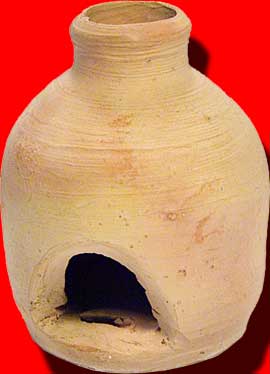
H max: 6cm D max: 5 cm Col. particulière |
||||||||
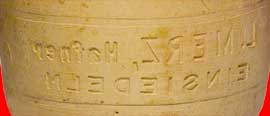 The potter's mark reversed on the whistle.
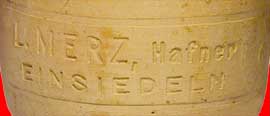 and on the right way to read it. L. Merz Hafner Einsiedeln |
Einsielden: Einsielden is a little town in the canton of Schwyz in the center of Switzerland. In 835, Meinrad, a Benedictine monk from the Island of Reichenau in Lake Constance, withdrew as a hermit into the "Dark Forest". Other hermits followed, among them bishop Benno from Metz in Lorraine. In 934 Eberhard, a noble priest and canon of the cathedral of Strasbourg, assembled the hermits into a monastic community and in 934 a Benedictine monastery was founded. It was the foudation of the famous Abbey of Einsiedeln where have taken place till now many pilgrimages. For the studies about the Swiss Folk art and traditions, this town is wellknown because of the wooden masks used during the Carnival procession. .
| 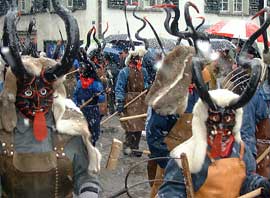 © David Simonetti |
|||||||
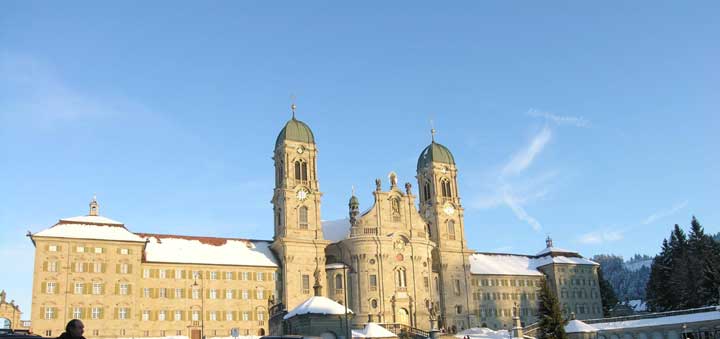 The Abbey of Einsiedeln.
|
|||||||||
| Study of the whistle: Typology: This is a globular whistle with one playing hole which produces a minor third. Those whistles are part of the A1 category of Mrs Nixdorf's classification. It is turned as a little vase and the bottom of the vessel wall is diagonnaly cut. The mouthpiece consists in a slit in the base opposite to the edge.
|
|||||||||
| Analysis:
|
|||||||||
Locally, those whistles are called "pfingstgugger" which can be translated 'Whit cuckoo'. The oldest written source about these whistles is probably a Meinard Lienert's poem written in 1917: "D'Waldlüt vo Einsiedle" about the people of Einsiedeln. He uses the word in the fourth verse : 'Pfingstetökelgschirrli' which probably covers the Pfingstgugger and Pfingstscheller, that is to say the ceramic bells and whistles of the Pentecost described in 1935 by Martin Gyr in his book about the folk traditions in Einsiedln: "Einsiedler Volksbräuche". It was during a youth festival in 1926 when were reintroduced these toys previously produced in the old little pottery workshops in Einsiedeln. For this period, the potter Lorenz Merz-Kälin produced those toys as we can see in his 'Totenbildchen' (Death cards given to the attenders of the funeral with a picture showing the person in his life) in January 1946 where is shown a shelf of bells and whistles. It is written "Sini tönigä Guggärä und Pfingstschällä sind jetz verklungä. (His Whit cuckoos and Whit clay bells are now faded awayThe whistle of the month was therefore turned between 1926 et 1946. Martin Gyr also wrote that those whistles were sold during the Pentecost fest. For that time, the potters made miniature dishes as well as bells and cuckoos (but those last ones were unglazed). On Whit Sunday morning, they have installed stands in front of the townhall. For one "batzen" (an old coin) they sold the toys to the children. At noon, bells and cuckoos sound in the village, harbingers of spring. Therefor, the sale of these cuckoos is a classical illustration of the whistling days spread all over Europe. | |||||||||
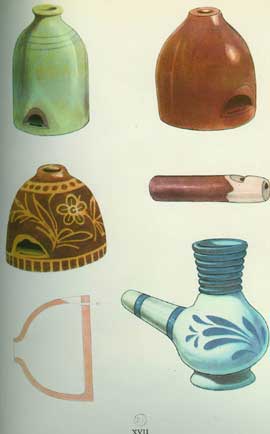 Czech cuckoos Museum of Klatovy. Illustration in "Folk-toys, Les jouets populaires" Emanuel Hercík 1949 |
Such whistles were made in all the Center Europe from Hungary to the south of Germany and Alsace. In Hungary, those "kakukkolô" have been sold during the religious fests until the 1960s,70s.
Hungarian cuckoo
by György Mezö 1979. Szeged. South Hungary in Osteurpaïsche Tongefässflöten. Peter Király |
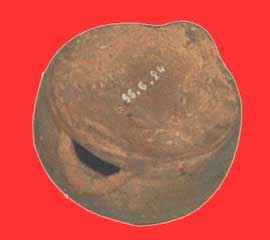 Cuckoo or 'reclin'. Lizine before 1890 Jura France Col. Musée Comtois Besançon
Cuckoo. Alsace France late 19 C -early 20 C. Private col.
| |||||||
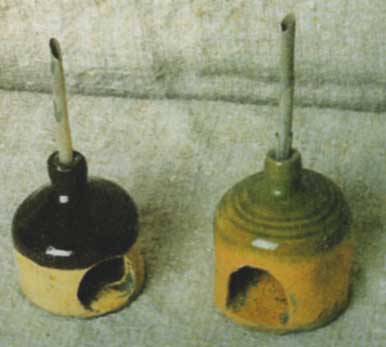 Barrolets (potter's horns) XIXe S. Musée Alsacien Haguenau |
Origin of this shape: The shape of those whistles is usually compared with the shape of the potter's horn, a little vessel used by the potter to do slip drawings and writings (the slip is liquid clay). In German, it is called a "malhörnchen": a little horn to paint. In other places, the potters used horns to make the slipwares. The oldest whistles have a sharper shape which is more similar to the original horn. Such a shape is just a way for the potter to make whistles like the horn ones. A horn shaped whistle dated 500-400 B J.-C. was founded near Poznan in Pologne and is a testimony of the antique origine of this shape in Europe.
Whistle dug in Komorovo (PL)
500-400 B J.-C. |
||||||||
|
The Swiss cuckoo nowadays:
Fortunately, the cuckoo of Einsiedeln is still singing nowadays. |
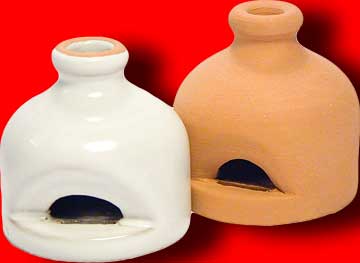
Present production W. Auf der Maur Private col. |
||||||||